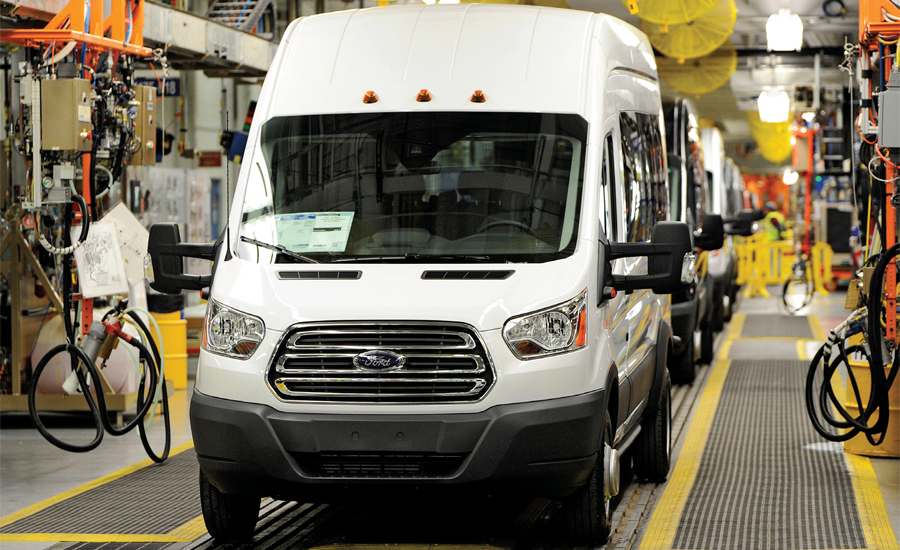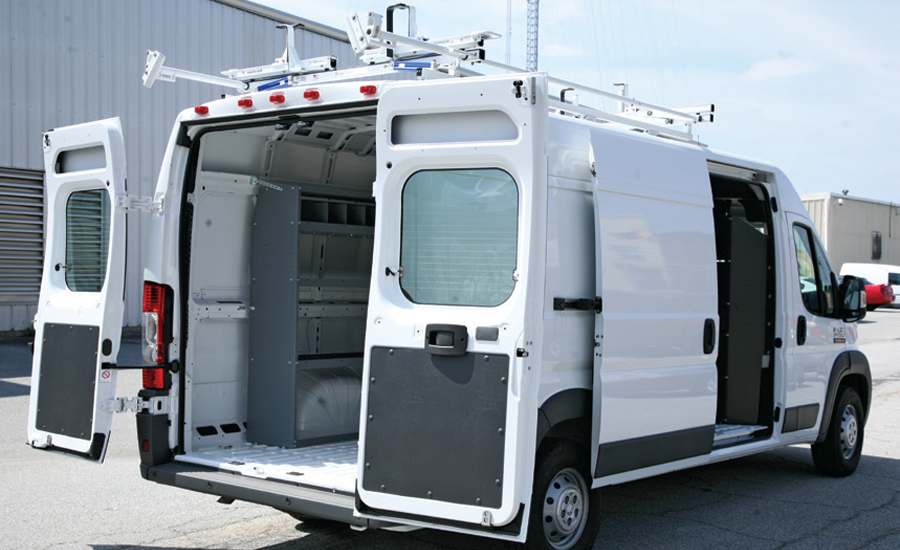Euro Cargo Vans Redefine Your Rolling Workshop

Ford has seen substantial growth in sales of full-size Transit vans since they started moving off the assembly line last year in Kansas City, Mo.
PHOTO COURTESY OF FORD MOTOR CO.

SOURCE: MANUFACTURERS

A dizzying array of cargo options is available for the new Eurostyle vans, such as this full-size Ram ProMaster.
PHOTO COURTESY OF LEGGETT & PLATT CVP



Last December, Leon LaJeunesse decided to shop for a work van for his general contracting business. He figured he’d find plenty of year-end incentives, but he didn’t expect to be sorting through an explosion of several new, odd-looking models on dealers’ lots.
“I’ve already got two Econoline vans,” says LaJeunesse, referring to Ford’s body-on-frame E-Series van that it discontinued last year in favor of the European-style, unibody Ford Transit. “I was looking for a small van—almost a portable gang box for getting in and out of the city.”
The president of Lake Zurich, Ill.-based Custom Contracting tested out several smallish vans, including Ford’s Transit Connect—a compact version of the larger Transit—before purchasing a 2014 Ram C/V, a midsize hauler based on the Dodge Caravan.
Today, the C/V is no longer available, as Ram replaced it this year with the Fiat-based ProMaster City, a small version of the full-size ProMaster. Still, “I got exactly what I wanted,” says LaJeunesse. “A lot of times, there is barely any laydown space for materials, so we’ve got to be minimal in what we leave on site. We use this as a just-in-time delivery service.”
Cargo vans are making a big comeback. Market leader Ford reported in September its busiest month for commercial vans since 1987, selling 17,994 vehicles, an annual increase of 65%—nearly four times stronger than the growth rate of pickup trucks. The uptick is partially due to replacement needs—on average, commercial owners keep their vans for 11 years or more—but the expanding options in models, configurations and capabilities also are boosting sales.
The new influx of Euro-style vans may take some buyers by surprise, with their stubby noses and tall profiles. “In the van segment, form follows function,” says Dave Sowers, head of Ram’s commercial vehicle marketing. “Everything here starts with capability and efficiency.”
Every day, contractors are finding new ways to use cargo vans to become more productive and profitable. Full-size vans like the Ford Transit, which comes in two wheelbases, three body lengths and three roof heights—with a maximum cargo volume of 487.3 cu ft, maximum payload of 4,560 lb and a starting price of $32,155—make haulers like bulky, fuel-thirsty box trucks seem less appealing.
“These new vans have revolutionized what businesses can do with them,” says Yaro Hetman, Ford’s van brand manager. “Instead of dragging around on the back of a truck little huts, contractors can set up a workshop and computer in a high-roof van and simply drive from site to site. That’s something you never could have imagined on the old body-on-frame, traditional E-Series.”
For users who still want flexible body options, Ford is still building E-Series cutaways as well as Transits in cutaway and chassis-cab configurations. And although Ford, Mercedes-Benz, Nissan and Ram have all joined the unibody van craze, body-on-frame traditionalists can still turn to General Motors for its Chevrolet Express and GMC Savana full-size vans, which offer best-in-class towing of 10,000 lb.
For many tradespeople, being able to stand up inside a tall work van is a productivity game-changer, not to mention a back-saver.
“Our most popular model is the medium-roof, long-wheelbase Transit,” Hetman explains. “In a medium roof, you can stand up tall even if you are at 6 feet, which covers the majority of individuals. At the same time, you are getting fuel efficiency that is similar to the low-roof vehicles.” The high-roof Transit allows a person as tall as 6 ft 5 in. to stand up fully without craning his neck.
Manufacturers of today’s full-size vans are not required to report fuel economy estimates, but Hetman says users can expect to see up to 46% better fuel efficiency and 75% more cargo capacity than the discontinued E-Series. For full-size vans equipped with a diesel engine, buyers can expect to see unladen miles per gallon in the low to mid- 20s, Sowers notes.
And while towing with a van is sometimes needed, users are finding they can carry more materials and gear in the back without hooking up a trailer.
“Some people will get a tow package just to have it in case they need to tow,” Hetman says. “With the E-Series, you have to tow more to get all your tools to your site, but with Transit’s close to 500 cubic feet of cargo capacity, you can fit most of those tools and not have the fuel economy degradation of having to tow something.” Mercedes-Benz has the most cargo room in the class with a volume of up to 586.1 cu ft.
Models in the compact class are equally impressive in their hauling capacity and efficiency. Highway fuel economy in the mid-to-high 20s is not out of the question, and many can swallow a 4x4x4-ft pallet with room to spare. A mind-numbing array of cargo bins, shelves, racks and bulkheads are available to make the most of an interior.
The increase in storage options has given contractors “an opportunity to really nail down what it is that they want to do,” says Jason Lehman, vice president of sales for Atlanta-based upfitter Leggett & Platt Commercial Vehicle Products. A year ago, the commercial upfitter, which manufacturers racks, bins and other cargo organizers, moved into a 72,000-sq-ft ship-through facility in Kansas City, Mo., just down the road from Ford’s van factory.
With upfitting, “your imagination is where it ends,” Hetman says. “We have had 12 upfitters create facilities within 20 miles of our Kansas City plant. Some of them are multimillion-dollar facilities specifically dedicated to upfitting Transits.”
Upfitters are constantly thinking of clever options. “A lot of times, in construction, contractors would utilize a service body on a cab chassis whereas now they can go buy a vehicle off a dealer lot and have the shelving installed in our location,” Lehman explains. “It’s probably a little less expensive for them than what they have done in the past.”
For contractors needing to haul tools and supplies, the new vans accept a wide variety of materials for cargo bins, such as steel, aluminum, wire and composites as well as ladder roof racks. Some users are even putting stepladders inside the van simply because more space is available.
“Instead of putting roof racks on the roof, a lot of contractors and tradespeople can put the rack inside, which [produces] almost a 30% decrease in fuel consumption,” Hetman says. “Some people still prefer to have the ladder on top, but we’ve definitely seen a shift.” Super-long extension ladders may still need to go topside, however.
Even more cargo van options are on the way. Within the small-van class, which includes the Ford Transit Connect, Ram ProMaster City, Nissan NV200 and its twin, the Chevrolet City Express, a new midsize model is joining the fray: the Mercedes Metris. On sale since October, the van, which can haul up to 2,500 lb in the back and is priced at just under $30,000—making it the lowest-cost Mercedes vehicle in the U.S.—fills a void that Ram left wide open when it discontinued the C/V this year.
LaJeunesse says he wasn’t too happy about that move, but he plans to keep his C/V van busy for years to come.
TAKING VANS TO TASK
- Unibody vans are replacing those with body-on-frame construction.
- New full-size vans reach MPGs in the high teens to low 20s.
- Compact or midsize vans are more economical for light hauling and towing.






